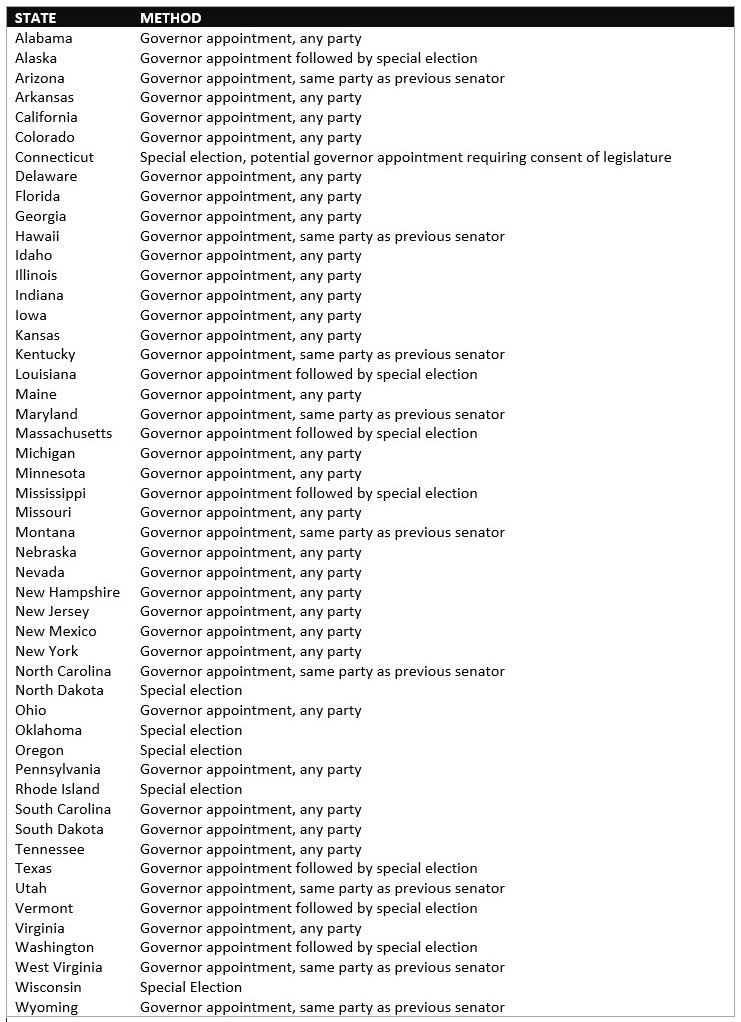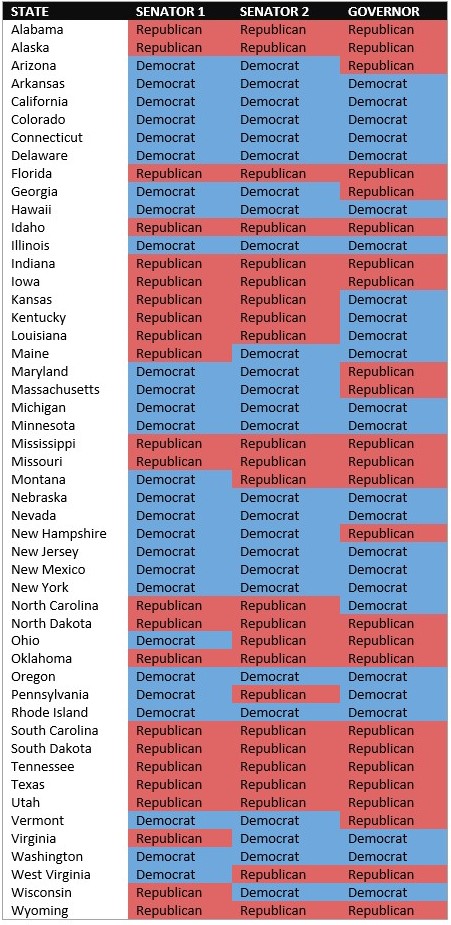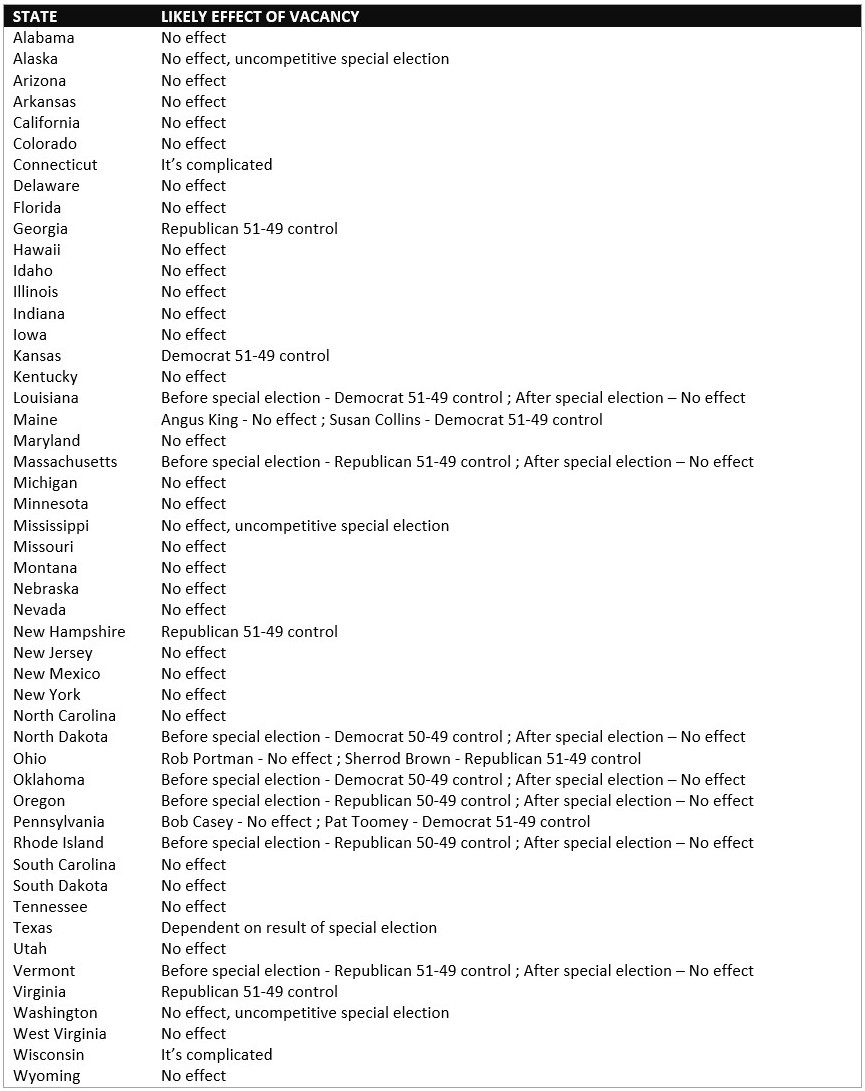How Vacancies Could Affect a Razor Thin Senate Majority
Originally Posted: September 26, 2021
Update 1/3/2022: This post was updated to reflect the results of the 2021 Virginia Gubernatorial election.
Note 7/29/2024: Some source links have since been updated by the original authors to reflect more recent polling results, rather than the old results referenced in this post.
Democrats currently control the Senate by the thinnest of thin majorities: 51-50. This means that it is the Vice President's tie breaking vote that grants them control of the chamber. This creates all kinds of (not so) fun consequences, like requiring Joe Manchin (D-WV) and Bernie Sanders (I-VT) to be on the same page for anything to move through the chamber without Republican support, perpetual debate about the filibuster, and the looming threat that it only takes the absence of one senator to potentially shift the balance of power dramatically. With the average senator being 64, and the oldest being 87, this makes the somewhat morbid "What if?" question especially relevant. If a senator were forced to resign for any reason, were cast out of the chamber, or yes, were to die, how would that affect the balance of power in the chamber, and as a result, in all of Washington?
Before we analyze this in detail, first, a quick recap. The Senate has 100 members, 2 from each state. Currently, there are no vacancies, so every seat is filled. One member (Alex Padilla, D-CA) was appointed to fill the seat vacated by Vice President Kamala Harris and will serve out the remainder of the term through the end of the current Congress. Two members (Mark Kelly, D-AZ and Raphael Warnock, D-GA) were elected in special elections to finish terms that expire at the end of the current Congress. The partisan makeup is a 50-48-2 split, with 50 Republicans, 48 Democrats, and 2 Independents. However, both Independents (Angus King, ME and Bernie Sanders) caucus with the Democrats, giving the chamber its 50-50 split. In such a case, the majority party is decided by the party of the Vice President (the President of the Senate) who is currently a Democrat.
Majority control of the Senate is incredibly important, as the party in charge can dictate what bills come to the floor and which nominations receive consideration. The latter was especially important at the end of the Obama administration when a Republican led Senate blocked the nomination of Merrick Garland to the Supreme Court. This is why any change in the current makeup of the Senate could have very important implications for the agenda of President Biden, and Democrats overall. If any change were to occur that would give Republicans control of the chamber, Mitch McConnell (R-KY) would become majority leader, and he would likely continue his Obama-era strategy of blocking all legislative action. Alternatively, if Democrats suddenly found themselves with a 51-49 or even a 50-49 Senate, they could afford to lose the vote of one member and still pass legislation along party lines. This would most likely shift the center of focus from Joe Manchin to Kyrsten Sinema (D-AZ). The immediate effects of this almost certainly wouldn't be that large, as there appears to be little daylight between Manchin and Sinema on many issues, but it would offer a little more wiggle room in negotiations.
Filling Senate Vacancies
If a seat were to become vacant, there would be one of two immediate consequences
- A 50-49 Deomcrat led Senate, or
- A 50-49 Republican led Senate
depending on the party of the member who vacated their seat.
Either of these states isn't likely to last long though, as we would then begin the process of filling the vacancy. This is where things get interesting, as each state has a different procedure for finding an interim Senator. Below is a list of each state, and a quick summary of their procedure for filling a Senate vacancy.

In general, the states can be broken into three categories when it comes to how they fill a Senate vacancy.
- The governor appoints someone to fill the seat until the next general election. There are different rules on whether or not that person has to be of the same party as the senator who left the vacated seat.
- If there is enough time left in the term, a special election is held to fill the seat. The governor is allowed to appoint someone in the interim.
- If there is enough time left in the term, a special election is held to fill the seat, but the governor is not allowed to appoint someone in the interim. The seat is left vacant until an election can be held.
As we can see, it is not just the party of the senators, but the party of the governor that is important. But what does this look like in each state? Below is a list of all 50 states and the party of their senators and of their governor. In summary,
- 18 states have a Republican trifecta,
- 15 states have a Democratic trifecta,
- 7 states have Democratic senators but Republican governors,
- 4 states have Republican senators but Democratic governors,
- 3 states have a split Senate delegation with Republican governors, and
- 3 states have a split Senate delegation with Democratic governors.

Note: In the above chart both of Virginia's senators should be Democrats and the governor should be Republican.
How it Changes the Senate
So, what would actually happen if any given Senate seat were to become vacant? In some cases, this is straightforward, in others, not so much. There is also of course no way to know for sure what would happen exactly. Governors could make unexpected choices and elections could have surprise outcomes. But if we make some basic assumptions, like that governors will always appoint someone from their own party, and that these special elections won't wildly buck the state's political trend, we can get some good ideas of how everything would turn out.
We'll set aside the immediate consequences of a seat opening up, as appointments would likely be made within days, and just focus on what happens after the rules for filling the vacancy begin to take effect. We also are only concerned with how this would affect the Senate through the end of the current Congress. A summary of how this looks in every state is listed below, but let's walk through it all, especially since some states can get pretty complicated.
First, the topline results everyone cares about. Which party has the advantage here?
- There are 17 senators who could create a vacancy that would permanently or temporarily give Republicans control of the chamber.
- There are 12 senators who could create a vacancy that would permanently or temporarily give Democrats a 51-49 or 50-49 majority in the chamber.
- There are 2 senators who could create a vacancy that would lead to a complete wild card situation (more on this later).
Now, for some more detail. First, the straightforward cases:
- There are 63 senators where the governor would appoint a replacement, who would serve through the end of the Congress, that wouldn't change the partisan makeup of the Senate. These are the senators from Alabama, Arizona, Arkansas, California, Colorado, Delaware, Florida, Hawaii, Idaho, Illinois, Indiana, Iowa, Kentucky, Maryland, Michigan, Minnesota, Missouri, Montana, Nebraska, Nevada, New Jersey, New Mexico, New York, North Carolina, South Carolina, South Dakota, Tennessee, Utah, West Virginia, and Wyoming, as well as Bob Casey (D-PA), Angus King (I-ME), and Rob Portman (R-OH).
- There are 7 senators where the governor would appoint a replacement, who would serve through the end of the Congress, that would give Republicans control over a 51-49 Senate. These are the senators from Georgia, New Hampshire, and Virginia, as well as Sherrod Brown (D-OH).
- There are 6 senators where the governor would appoint a replacement that would not change the partisan makeup of the Senate. However, the replacement would have to run in a special election for the seat before the end of the current Congress. However, the elections are unlikely to be competitive and the appointee (or someone else from the same party) would be all but guaranteed to win. These are the senators from Alaska, Mississippi, and Washington.
- There are 4 senators where the governor would appoint a replacement, who would serve through the end of the Congress, that would give Democrats control over a 51-49 Senate. These are the senators from Kansas, as well as Susan Collins (R-ME) and Pat Toomey (R-PA).
Now for some of the more complex cases:
There are three states where the governor's appointment could temporarily give one party a 51-49 Senate, but if a special election were held, this would likely be reversed back to the current 50-50 Senate we have today. The catch is that the special election isn't held if the vacancy happens after a given date. This would allow a 51-49 Senate to solidify for the rest of the Congress.
- There are 4 senators where the governor would appoint a replacement that would create a Republican controlled 51-49 Senate. These are the senators from Massachusetts and Vermont. However, if the vacancy occurred before April 10, 2022 in Massachusetts, or before May 8, 2022 in Vermont, a special election would be held before the November 2022 general election that would likely restore the Senate to its current 50-50 balance.
- In the same way, there are 2 senators (Louisiana) where the governor would appoint a replacement that would create a Democratic controlled 51-49 Senate. However, if the vacancy occurred before January 3, 2022, a special election would be held before the November 2022 general election that would likely restore the Senate to its current 50-50 balance.
Similar to the above cases, there are four states where the governor cannot make an appointment, and so the Senate would temporarily be down one member until a special election could be held. Again, the catch is that the special election isn't held if the vacancy happens after a given date. This would allow a 50-49 Senate to solidify for the rest of the Congress.
- There are 4 senators where a vacancy would temporarily create a Republican controlled 50-49 Senate. These are the senators from Oregon and Rhode Island. However, if the vacancy occurred before September 8, 2022 in Oregon, or before July 1, 2022 in Rhode Island, a special election would be held before the November 2022 general election that would likely restore the Senate to its current 50-50 balance.
- There are 4 senators where a vacancy would temporarily create a Democratic controlled 50-49 Senate. These are the senators from North Dakota and Oklahoma. However, if the vacancy occurred before September 30, 2022 in North Dakota, or before January 1, 2022 in Oklahoma, a special election would be held before the November 2022 general election that would likely restore the Senate to its current 50-50 balance.
And finally, the wild card cases. Let's go from most predictable to least predictable:
- Connecticut: This isn't really a wild card, but it is weird. In most cases, if a vacancy were to open up in one of the Connecticut Senate seats, a special election would be held to fill it, and the governor would not get to make an interim appointment. This would temporarily create a 50-49 Republican Senate, and then almost certainly restore the Senate to its current 50-50 balance after the election. However, if Richard Blumenthal's (D-CT) seat were to open up between the November 2022 election and the start of the next Congress (when his current term expires), the governor would be allowed to appoint a replacement until a special election could be held. However, this appoint would have to be confirmed by a two-thirds majority of both chambers of the state legislature. Currently, Democrats only hold such a supermajority in one house. It is therefore likely, that were this to happen, Republicans in the state legislature would block the appointment of a Democrat to fill the seat, solidifying a 50-49 Republican Senate for the last few months of the current Congress. This would almost certainly hold over until a special election could be held, probably sometime in early 2023.
- Texas: If a vacancy were to open up in one of the Texas Senate seats, the governor would get to appoint a replacement. This would keep the Senate at its current 50-50 balance. However, the vacancy would almost certainly trigger a special election. There has been a lot of talk for a long time about Texas turning blue, but so far that hasn't materialized. However, this would be an extremely high-profile election for control of the Senate, much like the Georgia Senate runoffs in 2021. It is therefore possible, although unlikely, that this would generate the environment needed for a Democrat to win statewide in Texas and cement a 51-49 Democratic majority in the Senate.
- Wisconsin: The true wild card. First, some straightforward scenarios. If a vacancy opens up after April 12, 2022, it will likely be filled on or shortly after the general election in November 2022. Since Wisconsin has a split Senate delegation, that would mean that in the meantime the Senate would have a 50-49 split, with either Democrats or Republicans in charge, depending on which seat was vacated. However, if the seat was vacated before April 12, 2022, a special election would be held before the general election in November 2022. Depending on which seat was vacated, and who won the special election, this would have the potential to create a 51-49 Republican Senate majority, a 51-49 Democratic Senate majority, or maintain the current 50-50 balance. Unlike other special election states though, it is entirely unclear which party would emerge victorious. In 2020, Wisconsin had no senator up for election, and the state went to Joe Biden. In the 2018 midterms, the state elected a Democratic senator and a Democratic governor. In 2016 the state elected a Republican senator, and the state went to Donald Trump. And then there's the complicating factor that the President's party typically performs poorly following a presidential election. Recent polls give Democrats an edge in statewide races, but much like Texas, this could all change when it's a high-profile race for control of the Senate. Unlike Texas though, I don't think there's a strong prior for which party would triumph here. Thus, the true wild card.
